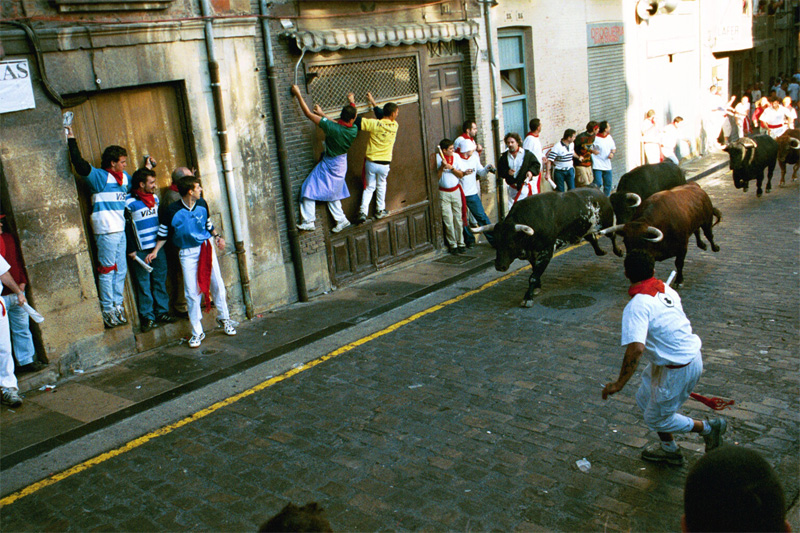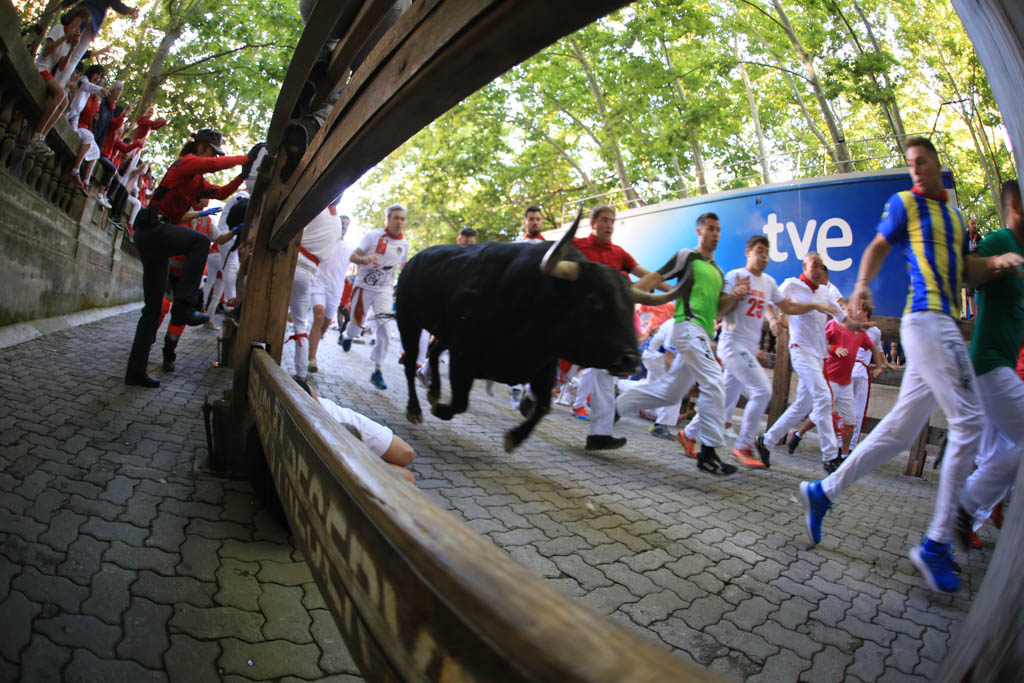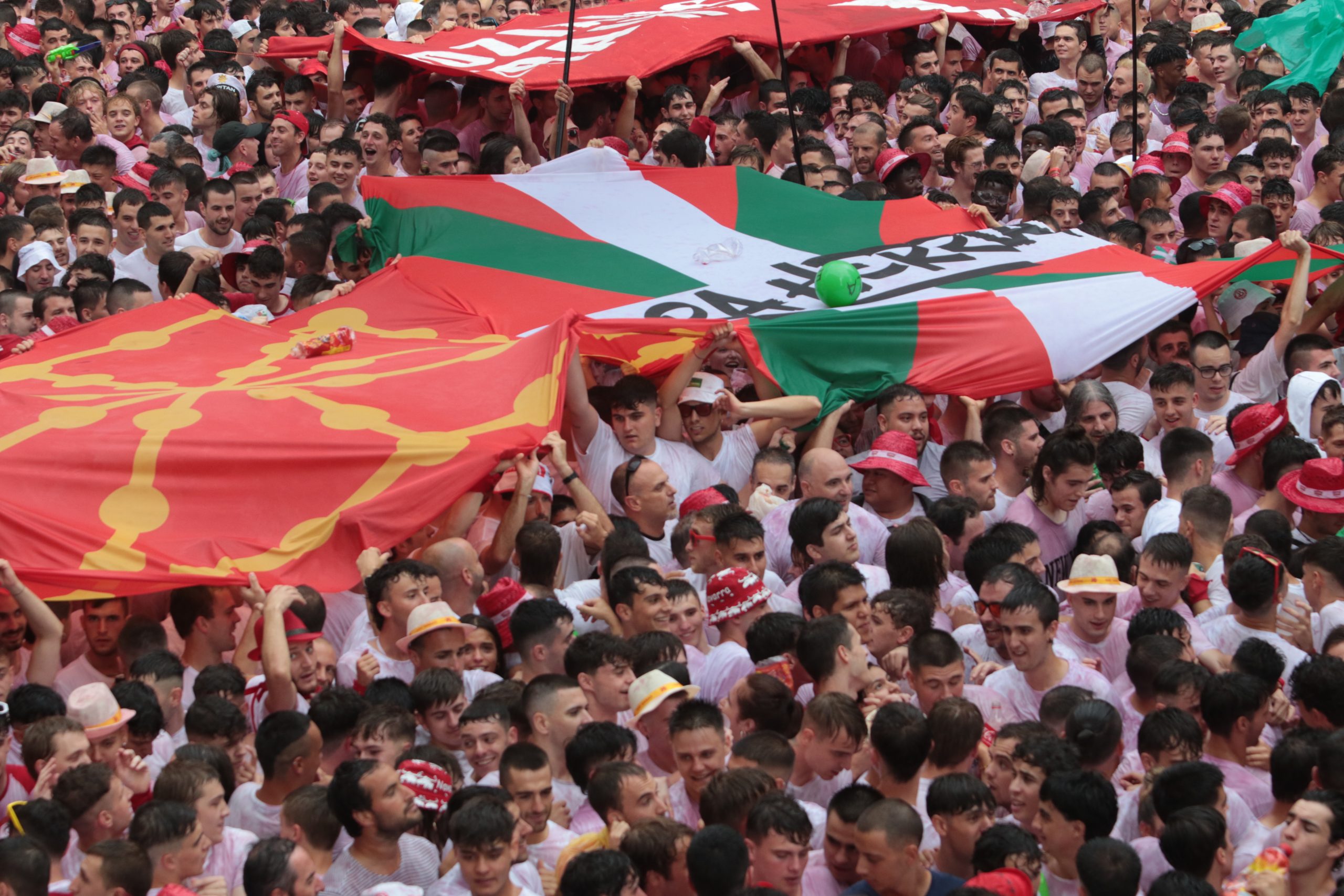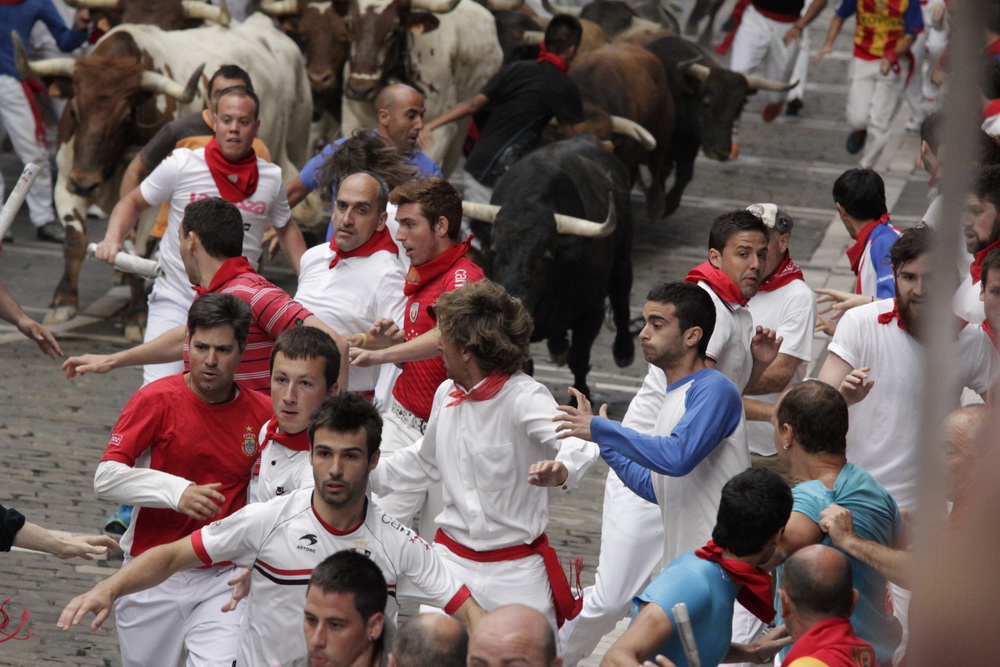Cover Photo. © Mikel Lasa. Santo Domingo. 2002.
When the Larrequi-Herrera family left their flat in Pamplona to go and watch the bullrun, on the morning of the 8th of July, 1939, they could never in their wildest dreams (or perhaps more correctly, nightmares), have thought that the family were about to become a part of fiesta history.
The bulls, those incredible beasts whose very presence in the town seem to pulse through the veins of everyone, were being prepared to be let loose in the street just about 800 yards away, and one of them, Liebrero, was also about to make his mark in the history books of this amazing town. He and his bovine brothers were from the Sanchez Cobaleda ranch.
Actually, none of the family should have been there that morning for the encierro. They had really been enjoying the fiesta, along with so many others, as 1939 was the first fiesta since 1936, as it had been cancelled for two years due to the civil war. All of them had enjoyed the previous day, especially the two oldest children, ( the oldest being 20, and both of whom had fought in the civil war and returned scarred, not surprisingly, from the conflict), and both had run in the encierro of the 7th of July. But that night, when they had all returned and gone to bed, their father changed the alarm clocks and set them to 8 o’clock, so they could all have a decent sleep, but more importantly so that his two older sons would wake up late and so not be able to run the following morning.
But his little trick didn’t work, as the following morning the sunshine woke up the youngest ones, who woke up the rest, so their mother, Clara, felt she had no option but to accompany them to see the run. The family lived at the time above what to many of us will always be the old bus station, which was then still pretty new, so they didn’t have far to go, although in reality they were at the edge of town. The two oldest boys promised their father that they wouldn’t run, and the mother and her six children headed towards the Plaza de Toros. They were running late but would make it with a few minutes to spare. The children were the two youngest daughters, Aurelia, aged just 10, and her sister Maria Jesus, aged 13, followed by Ignacio aged 11, Luis, 16, and finally Pedro, the oldest at 20. Yup, one is missing there, the second oldest son, and search as I have, I cannot find his name in any of the articles I have read. Perhaps he never actually went with the rest of them after all.
But when they got to the bullring it was already full, and here is where fate stepped in, because instead of returning home, they still wanted to see something, and as there were only a few minutes to go, they quickly found a spot at the barriers in Telefonos. As one of the brothers, Ignacio said, “We were just youngsters and it was easy to slip into the first row”.
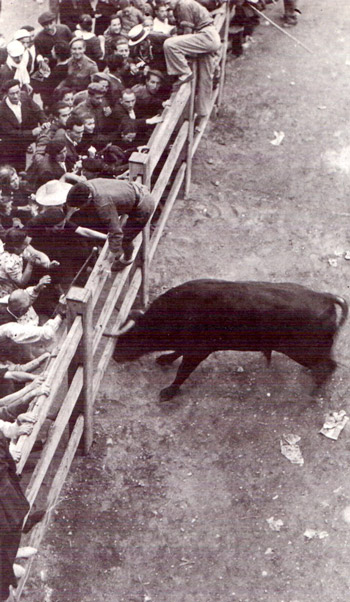
As the bulls came into view leaving the Estafeta and entering Telefonos, they headed downhill towards the callejon, the tunnel into the ring. A man dressed up as a soldier, or perhaps he really was a soldier, attracted the attention of the bull “Liebrero”, which charged the barrier. Bulls had done this on the run many times before, of course, except this time…the barrier broke. In those days, there was only row one of fencing, not the two they have now. As a consequence of this event, the planks were reinforced with iron, and from 1942 they installed the double row of barriers we see nowadays. I haven’t been able to find out the name of the man who caused all this, or indeed if he was a real soldier.
Well, you can imagine the panic. As it became obvious the bull was going to be able to break through the wooden planks, the crowd stampeded and scattered.
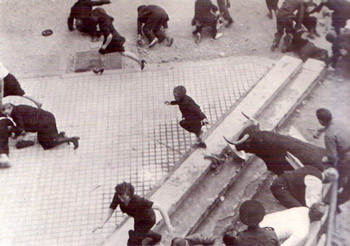
With people running in every direction, it looked like the youngest of the children, Aurelia, was about to get gored, because as you can see from the picture above, she was literally in front of the horns. However, the bull didn’t get the girl, for whatever reason, (some said her mother distracted the bull having seen her daughter was in trouble, but as she is already on her knees and falling to the ground in the photo above, I’m not too sure). But maybe as she turned and fell she saw and cried out…who knows. Also in the photo above you can see the 11 year old Ignacio, at the very top right wearing a white shirt and darker shorts.
What we do know is that Aurelia escaped unharmed, as the bull went straight for her mother, and gored her twice, in a part of the body too delicate to mention here.
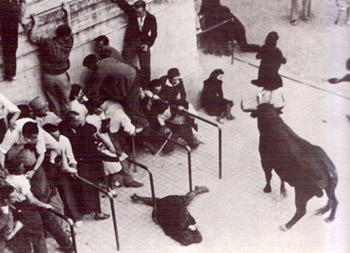
While people obviously tried to get as far away as possible, or indeed, as you can see from the photo, as far up the wall as possible, it seems the bull was distracted by 16 year old Luis. Who hit it. Whatever happened, it worked and the bull then turned and went after others, including Maria Jesus, Aurelia’s 13 year old sister. She’s the one in the photo wearing a black dress with white collar, carrying a handbag in her right hand. She also managed to escape injury, as did everyone else who was involved that day.
With the help of other people, Luis and the little Ignacio carried their mother into the infirmary inside the bullring, then run by a Doctor Jauristi, who took the first steps to stabilize their mother, before her transfer to hospital, where she spent the next 34 days. But she survived, and was back the next year watching the bulls, as she continued to do every year until one day she thought she saw one of her sons being gored. Fortunately it wasn’t him, but she never returned to watch the encierros after that. She still remains, however, the most seriously a woman has been injured due to an encierro.
The extraordinary photos above were taken by Jose Galle Gallego, who had a photo shop in Mercaderes street. A curiosity (and a sign of how times have changed), is that there was one other photo taken by him, that no one ever saw, as he destroyed the negative, because, say the now grown up children “he was a gentleman”. That photo showed their mother up in the air when the bull tossed her, and her dress wasn’t covering her knees. So to protect her modesty, he made sure no one would ever see it. As I said, how times have changed…
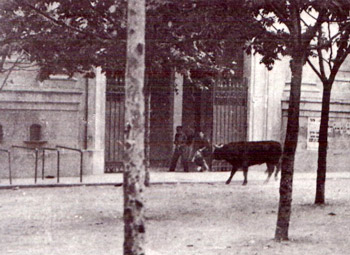
And finally, what of Liebrero? Well, you can see him in the picture above outside the bullring, and if my eyesight isn’t too bad I believe there appears to be a uniformed figure with a rifle standing in front of the main entrance, and he is a man called Cipriano Huarte. He was a Navarran, born in Olite. I can’t find a copy of this particular photo with his name attached to it, but I would like to think, indeed I am sure, that it is him.
After causing the carnage he had caused, Liebrero, this very mobile beast, had wandered around the outside of the bullring, until he stopped at the main entrance, next to the ticket booths. A member of the Guardia Civil had also made his way there to confront the animal, and that man was Cipriano Huarte. As he was only a couple of meters from the bull, one can only imagine what was going through his mind.
Oh so gently, and very carefully,and in silence, he prepared his rifle…and dropped the loading breech onto the ground. You couldn’t script it. I would like to think he uttered the word “joder!” under his breath.
Not panicking, and with great slowness, so as not to provoke the animal, he bent down, while never taking his eyes off the bull, and retrieved the thing, and prepared the gun once more. Then he calmly raised it to firing level…and with one shot Liebrero was dead. Señor Huarte himself eventually retired with the rank of colonel.
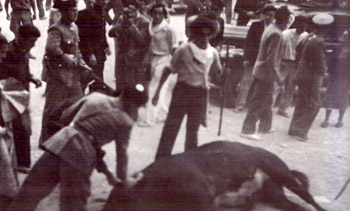
For those of us who have had the pleasure, honour, (and in my case, the bum numbing fear) of running with these beautiful and noble animals, we know just how amazing they are. Unfortunately though, we also know that on any given day with an encierro there will also be death, because as the afternoon ends and the evening begins, those six brave and innocent bulls will die in the ring.
Occasionally, and tragically, a human will die too, and it has happened 15 times since 1924, and before that…who knows. And once, in 1939, the encierro nearly took the life of a child or two. And their mother. Proving, as so many of us know, that anything, just anything, can happen in a bullrun.
Why, even a dog (You can read about the perro Ortega in this link) once risked all in the ring.
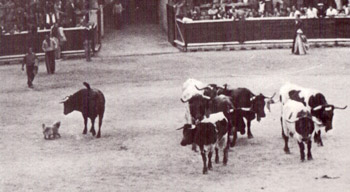
¡Ya falta menos! ¡Viva San Fermin!

